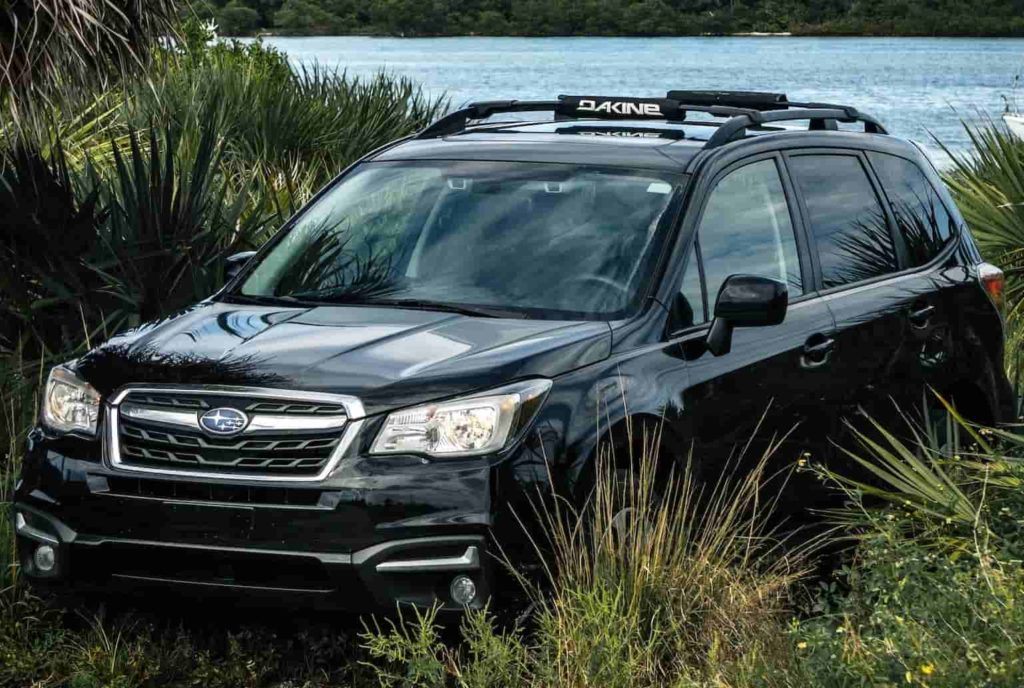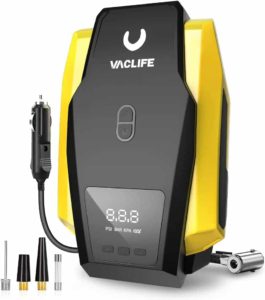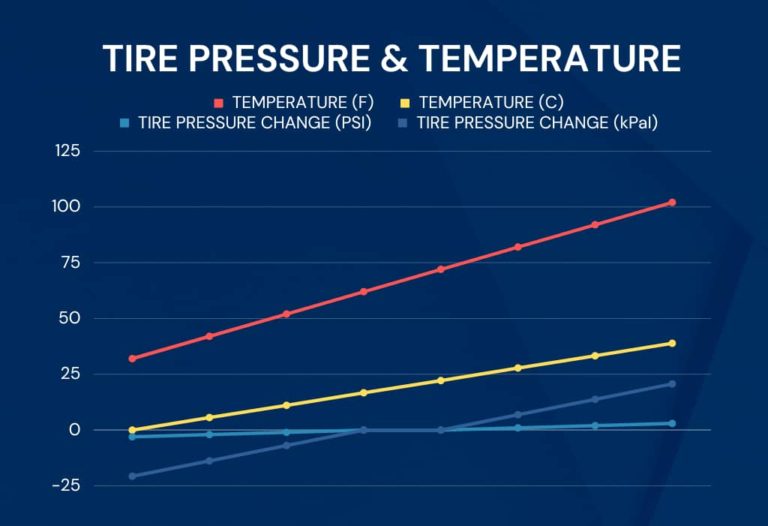There’s no button to turn off the tire pressure light in the Subaru Forester. Ignore any sources saying there is. Here are 9 easy steps to turn off the tire light and an explanation of how it functions!
What is the TPMS in a Subaru Forester?
The Subaru Forester has a feature called the Tire Pressure Monitoring System (TPMS) to keep your car safe and efficient. It constantly checks the pressure in your tires. If the pressure in any tire gets too low, a light on the dashboard turns on to let you know. To check your current tire pressure: Find the 3 buttons with the up and down arrow on the bottom left of your steering wheel. Use the top or bottom arrow to scroll through a list of screens until you see the tire pressure screen.
Subaru Forester Tire Size and Pressure
TIRE SIZE | FRONT PSI | REAR PSI |
225/55R18 | 35 | 33 |
225/60R17 | 33 | 32 |
SPARE TIRE | 60 | 60 |
Steps to Reset Subaru Forester Low Tire Pressure Light
The Subaru Forester does not have a tire pressure reset button.
When the tire pressure light on the dashboard lights up, pull over slowly and check your tire pressure right away.
Determine which tire is causing the tire pressure light to turn on and adjust the tire pressure accordingly. (the TPMS lets you know which tire is low on your screen by displaying the low pressure value in yellow instead of white)
Fill your tires to the exact recommended pressures. I cannot emphasize this enough, accuracy is key.
Drive your Subaru Forester. Drive for 10 minutes at speeds over 20 Mph.
If the light doesn’t go off right away, re-check your tire pressure to make sure they are all at the exact pressure you set them to. If they are down in pressure, you probably have some sort of tire leak.
If the pressures are at the exact pressure you set them to and the tire light still won’t go off, over fill your tires.
We recommend filling your problem tire with 45 Psi or about 10 Psi over the recommended pressure. With the tire overfilled, drive the car again for 10 or 15 minutes. This will turn off the tire light.
Now that the tire light is off, readjust the pressure back to the recommended Psi.
One more option, if you followed all these steps and the light is still on, check your spare tire. Some Subaru’s (depending on the package you have) do have a full size spare with a pressure sensor in them. Make sure your spare tire has 60 Psi. Now drive the car again.
What is the Subaru Forester TPMS Malfunction Indicator?
As mentioned above, the Subaru Forester’s tire pressure monitoring system has a malfunction indicator to alert you when something is wrong with the system itself. This indicator uses the same yellow exclamation point as the low tire pressure light. The difference is that, if there is a problem with the system, the light will flash for approximately one minute before staying on. This flashing or blinking will happen every time you start your car until the issue is resolved. This means that when your tire light is flashing or blinking, the system will not be able to detect low tire pressure. Basically, a blinking tire pressure light means there is a malfunction within the TPMS itself, rather than an air pressure issue. This is usually due to a faulty pressure sensor in one of your tires (a dead battery). To determine which sensor is faulty, use a TPMS diagnostic tool and scan each sensor for diagnostic information. This will also occur if you are driving with your spare wheel on your car. (if the spare does not have a sensor in it)
How Does the Subaru Forester TPMS Work?
Tire Pressure Sensors: Each tire, including the spare (in some trims), in a Subaru Forester is equipped with a sensor. These sensors are located within the tire and are designed to measure the air pressure and temperature inside.
Data Transmission: The sensors transmit data wirelessly to a central receiver, often called the TPMS Control Unit or receiver module, within the vehicle. This transmission can occur when the vehicle is in motion as well as provide static readings.
Air Pressure Monitoring: The TPMS Control Unit is constantly monitoring the air pressure readings from each tire. It’s pre-programmed with the recommended tire pressure levels for the Forester.
Underinflation Detection: If the air pressure in one or more tires falls below the pre-programmed level, the TPMS Control Unit recognizes this condition as underinflation.
Warning Light Activation: Once underinflation is detected, the system triggers a warning light on the vehicle’s dashboard. This is a yellow exclamation mark inside a horseshoe-like symbol.
Continued Monitoring: If the warning light is triggered, the TPMS continues to monitor the tire pressures. If the pressure in the problematic tire increases to an acceptable level (If you’ve added air to the tire), the warning light will turn off by itself.
Routine Self-checks: The TPMS in the Subaru Forester also performs routine self-checks to ensure it’s functioning properly. If it detects a malfunction in the system itself, it may turn on a different warning light called the TPMS malfunction indicator that starts flashing/blinking.
Battery Life: The tire pressure sensors are essentially transmitters of data and they require batteries. These batteries have a limited lifespan and are not replaceable individually. Instead, when the battery in a sensor is dead or dying, the entire sensor needs to be replaced. They use similar batteries as wrist watches, but to access them you have to break open the sensor case leaving the sensor broken.
What Causes the Tire Light to Turn On?
Seasonal temperature changes: A drop in ambient temperature can cause tire pressure to decrease, triggering the warning light.
Tire puncture or leak: A sharp object or road debris like a nail or screw may puncture a tire, causing air loss which will of course activate the warning light.
Faulty tire pressure sensor: Damaged or malfunctioning sensors may provide inaccurate readings, resulting in a false alert. The only way to determine which sensor is faulty is to scan each sensor with a TPMS diagnostic tool.
Valve stem issues: A damaged or leaking valve stem can lead to gradual pressure loss and eventual activation of the tire pressure light. They make kits to replace the rubber gasket that usually goes bad.
Tire damage: Impact from potholes or hitting a curb can cause structural damage like tire bubbles, leading to pressure loss.
Sensor battery life: TPMS sensors are battery-powered, and over time, batteries die. (they usually last anywhere from 5-10 years) This will cause the tire pressure light to turn on. Again, you must use a diagnostic tool to determine which sensor is dead or dying.
Recent tire rotation or replacement: If the tires have been recently rotated or replaced, the TPMS may need recalibration to avoid false alerts. Sometimes the vehicle’s computer may think the front tires are in the rear and rear in the front after a rotation.
Wheel or rim issues: Damaged, corroded, or cracked wheels or rims can lead to air leaks and pressure loss. This is very common with low profile tires.
Altitude changes: Climbing or descending in elevation can affect tire pressure and trigger the TPMS warning. An additional 1.5 Psi per Km above sea level is required.
Natural pressure loss: Tires lose air pressure over time due to temperature changes and permeation. Tire dry-rot will happen to tires that sit.
Electrical problems or software issues within the car’s TPMS system. Occasionally the system may have a software update from Subaru.
Snow Tires: If you have a separate set of wheels/rims for snow tires, either swap over the sensors from your summer wheels or purchase a second set of 4 sensors for the second set of wheels/rims. If you are using one set of wheels for both sets of tires, do not worry about this.
What Happens When Tires are Underinflated?
Underinflated tires have many negative side effects on your Subaru Forester, including:
Decreased Fuel Efficiency: Underinflated tires increase the rolling resistance, meaning your car’s engine has to work harder. This will reduce the Forester’s fuel efficiency, resulting in more frequent visits to the gas station.
Reduced Tire Lifespan: Underinflation causes uneven tire tread wear, typically along the edges of the tire. This can significantly reduce the tire’s lifespan, leading to more frequent and costly tire replacements.
Overheating Tires: Underinflated tires are prone to overheating because of the increased friction between the tire and the road. Overheating can lead to tire failure, including dangerous blowouts.
Poor Handling: Underinflated tires negatively impact the vehicle’s handling. They can make the vehicle feel sluggish and unresponsive, and they can also cause the vehicle to pull to one side. This reduces your control over the vehicle, which can be particularly dangerous in emergency situations.
Increased Braking Distance: When tires are underinflated, braking distances increase. This is because there’s less surface area of the tire in contact with the road, reducing the tire’s grip and making it harder to stop quickly.
Damage to Wheels: Prolonged driving on underinflated tires can potentially lead to damage to the wheels, as the lack of sufficient cushioning from the tire can allow the rim to come into harsh contact with potholes or other road imperfections.
Increased Risk of Aquaplaning: Underinflated tires can increase the risk of hydroplaning in wet conditions. This is because the tire’s contact patch is compromised, reducing its ability to channel water away effectively.
Compromised Load Carrying Capacity: Tires support the weight of the vehicle and its load. Underinflation compromises a tire’s load carrying capacity, which can be particularly risky if the vehicle is heavily loaded or towing.
What Happens When Tires are Overinflated?
Overinflated tires will also create several problems for your Subaru Forester, including:
Reduced Traction: Overinflated tires are harder and have less contact with the road. This reduces the tire’s grip and traction, making the vehicle more prone to slipping or skidding, especially in wet or icy conditions.
Harsher Ride: Overinflation reduces the tires’ ability to absorb road shocks from bumps and potholes. This results in a harsher, less comfortable ride and could potentially damage the vehicle’s suspension components.
Increased Tire Wear: Overinflated tires tend to wear more in the center of the tread because they bulge out in the middle. This uneven wear can shorten the tire’s lifespan and also negatively impact the vehicle’s handling.
Greater Risk of Tire Damage: Overinflated tires are more susceptible to damage such as punctures and blowouts, particularly when driving over sharp objects or potholes. The increased pressure makes the tire more rigid and less able to flex and absorb impacts.
Longer Braking Distance: Overinflated tires can increase braking distances because of their reduced contact area with the road. This can make it harder to stop quickly, increasing the risk of getting in an accident.
Decreased Stability in Turns: Because overinflated tires have a smaller contact patch with the road, they provide less grip. This can make the vehicle feel unstable or unresponsive when turning, which can be particularly dangerous at high speeds taking turns.
Increased Interior Noise: Overinflated tires can increase the level of noise inside the vehicle. The reduced ability to absorb road shocks can lead to increased vibration and noise transmission through the vehicle’s structure.
Potential Damage to Wheels: Similar to underinflated tires, overinflated tires also increase the risk of wheel damage. The lack of flexibility can cause the rim to take more impact from potholes or other road imperfections. I have personally seen many cracked rims, it’s much more common than you might think!
How Does the Weather Affect Tire Pressure?
Weather changes will affect your tire pressure! When it’s cold, the air in your tires shrinks and the pressure goes down. This is a very common reason for tire pressure lights to turn on. When it’s hot, the air in your tires increases and the pressure goes up. This change in pressure is normal! Remember that for every 10-degree change in temperature, your tire pressure goes up or down by about 1 Psi.
Steps to Adjust Tire Pressure
Get a high-quality tire gauge.
Make sure to check the tire pressure when the tires are cold. “Cold” means your vehicle has been sitting for at least three hours or driven less than 1 mile in the past 3 hours.
Take off the valve cap from the tire valve stem.
Push the tire gauge firmly onto the valve to measure the pressure.
Compare the pressure reading with the recommended pressure on the tire information label.
If the pressure is lower than the recommended pressure, add air.
If the pressure is too high, let out some air by pressing the metal stem in the center of the tire valve. You can use any object like a screwdriver to do this. Be gentle.
Recheck the tire pressure with the gauge.
Don’t forget to put the valve caps back on to prevent leaks and keep dirt and moisture out.
When Should You Adjust Your Tire Pressure?
To get the most accurate tire pressure reading on your Subaru Forester, we suggest checking and adjusting it in the morning or after the car has been parked for a few hours. When you drive, the tires heat up and the air inside expands, giving a higher inaccurate pressure reading. So, don’t adjust your tire pressure when the tires are hot, as it will just cause overinflation problems. For the best results, make sure your Forester has been parked for a few hours before checking the air pressure.
Conclusion
Maintaining proper tire pressure is crucial to the safety, efficiency, and longevity of your Subaru Forester. The tire pressure monitoring system (TPMS) is an excellent and underrated tool designed to help you with this task. However, understanding how it functions and how to respond when the tire pressure warning light turns on is essential. From weather changes to tire damage, numerous factors can influence tire pressure, causing underinflation or overinflation. Learning to check and adjust your tire pressure properly is a simple task that can make a world of difference to your driving experience. Drive safely, and remember, your Subaru is designed to help you do just that! Everything in this article is applicable to all Subaru Forester models and trims. Including, Forester Base, Forester Premium, Forester Sport, Forester Wilderness, Forester Touring and Forester Limited.
Please note that this blog post contains Amazon affiliate links. This means that if you make a purchase through one of these links, we at TPMSRESET.com may earn a small commission at no extra cost to you. We only recommend products that we personally use and believe in. Thank you for supporting us.




